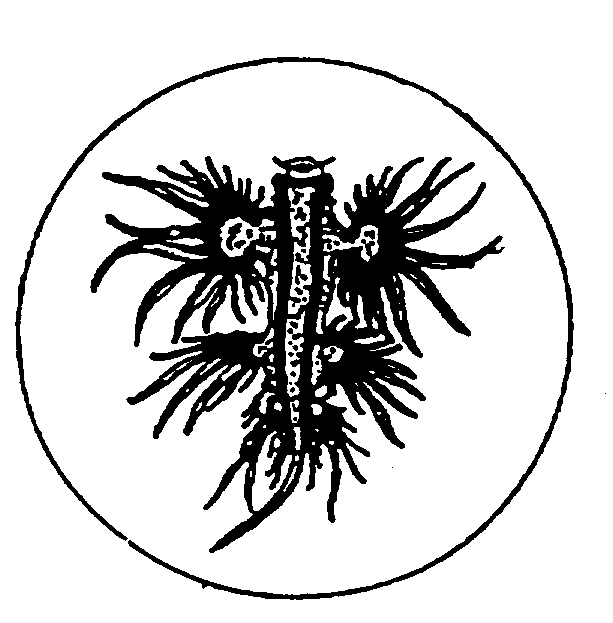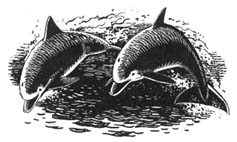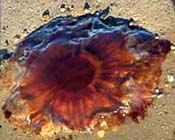
|
|
|
|
|
(BMLSS *** Site) |
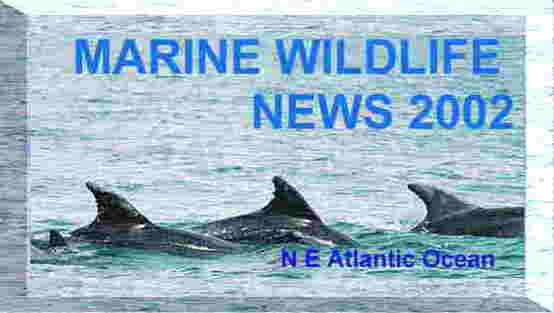
|
|
Norwegian Marine *** |
|
|
|
|
|
|
|
Recommended Sites |
|
|
|
DIARY |
|
|
|
Reports 1999 (by Ray Dennis) |
 |
|
|
|
|
 |
|
|
Marine
Wildlife News 1999
(British
Isles)
NE Atlantic Ocean.
New Millennium 2000 News Reports24 December 1999
Severe gales batter the south coast of England. Because the gales coincide with high spring tides (as high as they get), the south-east is effected by coastal flooding.22 December 1999
Winter Solstice
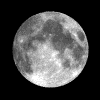
The last Full Moon of the 20th century is much brighter than normal and can be seen clearly before dusk.
NASA News Item
December 1999
A White-tailed Sea Eagle, Haliaetus albicilla, was observed out of its normal range (re-introduced to Scotland) on several occasions throughout the month, in the county of Norfolk on the east coast of England. The bird almost certainly arrived from continental Europe.from Robin Chittenden (East Anglia Birdline)
20 December 1999
A Fin Whale, Balaenoptera physalus, by Paul Semmons as a series of large blows about 7 miles off the coast of Cornwall in the direction of the Isles of Scilly .
The Fin Whale reaches a length of 24 metres (79 ft), and is the second largest species in the world. They are seen mainly in a sea area from north Scotland to south-west Ireland, although they have been seen between Cornwall and Ireland in the last few years.
Reported by Nick Tregenza EMail: nick@chelonia.demon.co.uk
Report from Vince Smith's One-List/Cornish Wildlife
British Cetaceans (Baleen Whales)
Cetaceans Information (Cornwall: Nick Tregenza)12 December 1999
A small oil tanker Erika with 26,000 tonnes of diesel fuel oil (the worse type of oil for causing environmental damage) sinks off the Biscay coast of Brittany in gale force winds.
The Erika split in two 45 miles (70 km) south of Brittany's rugged Finistere Peninsula on Sunday morning in 100 km (60 mile) winds and 6 metre (20 foot) waves. The total oil cargo is expected to be released into the sea. Some of the oil is intact in the tanks.
By 22 December 1999 the prospects looked very grim with the oil slick not broken up by the gales, and it is been blown inshore and is expected to make a large landfall near Ile d'Yea (island in the northern part of the Bay of Biscay) on Christmas Day. The toll of sea birds deaths is already very high.
Oilspills Page
Oiled Birds page
Oil Recovery from Sunken Tanker Erika Nearly Complete 2000 (Link)6 December 1999
A young 30 cm long (1 ft) Loggerhead Turtle, Caretta caretta, weighing 3 kg (6.6 lb), was discovered on a beach on Denmark's west coast by a nature warden and sent to Copenhagen Aquarium.
Loggerhead turtles, one of several endangered species of turtle, measure up to 110 cms (3.5 ft) and can weigh some 70 kg (154 lb) when fully grown.
from Reuters Planet ArkNovember 1999
A report has been received of a Kemp's Ridley Turtle, Lepidochelys kempii, stranded alive in Wales, UK. It was held in St. David's Oceanarium in Wales before being returned to Mexico. This turtle has only one wild breeding site, in the Gulf of Mexico and is the world's rarest turtle.
BMLSS Turtles Page30 November 1999
Barry Collins reported a roost of 146 Little Egrets, Egretta egretta, on Thorney Island in Chichester Harbour, West Sussex. This is a large number for a bird that is not even included in most modern bird books for Britain and Ireland. This number is fall from a count of 281 in September 1999.
More Information (Brian Fellows site)Information from Ralph Hollins
Little Egret in the Adur Estuary
Up until a few years ago they were vagrant, occasional visitors to the south of England only, but they have been especially numerous this year, no doubt attracted by the large shoals of young Bass around this autumn.
This bird has been recorded since 1826 on the south coast.
A Black Brant (Siberian Brent Goose), Branta bernicla nigricans, has also been reported from Langstone Harbour, West Sussex.
Hampshire Bird NewsHavant Nature Notes
BMLSS Sea Birds pageNumbers of Little Egrets on the Tamar/ Lynher complex in Cornwall peak at about 160-170, mostly in September when the post-breeding dispersal takes place. Around 30-40 spend the winter on the estuary and are best seen from Wacker Quay or Sconner Corner.
Darrell Clegg (Plymouth Library)
Little Egrets in Cornwall (more information and links)16 November 1999
A 2 metre long Striped Dolphin, Stenella coeruleoalba, was found washed up dead on Spiggie beach in the Shetland Isles. As this is a rare dolphin in British waters the entire carcass (which was in reasonably good condition) was shipped south for post-mortem analysis by Scottish Natural Heritage. It is only the fourth record of the species in Shetland waters
Shetland Wildlife Sightings On-line
Shetland Sea Mammal Report 1998
Full Report (Shetland Wildlife)
BMLSS Cetaceans10 November 1999
A juvenile male Thresher Shark, Alopius vulpinus, was landed in Guernsey. It was caught in gill nets about one mile south of Guernsey, Channel Islands, in about 20 metres of water. It measured 175 cm in total length, of which the long forked caudal or tail fin is about half this length.
More Information on Thresher Sharks
A Seahorse, Hippocampus hippocampus, was caught by the same fisherman.
Seahorses in British seasReports by Richard Lord (Guernsey).
EMail:fishinfo@guernsey.net
6-11 November 1999
Paul Parsons photographed one of two Triggerfish, Balistes capriscus, underneath the Palace Pier at Brighton, Sussex, in murky water. Triggerfish were previously thought to migrate back to warmer water or die during the winter. They may have not remained for the whole of the winter as the sea temperature off Sussex falls to 7° C.
Full Report5 November 1999
HISTORIC VICTORY FOR BRITISH MARINE LIFE
Oil licensing declared illegal until Government changes wildlife policyThe Government was defeated in court today (Friday 5th November 1999) in a
landmark legal ruling which protects coral reefs and whales and dolphins in
Britain's North East Atlantic. Mr Justice Kay ruled that all future offshore
oil licensing is illegal until the Government properly applies the EU
Habitats Directive.In his judgement, Justice Kay told the court that Greenpeace's case that
whales and dolphins can be harmed by oil industry activity was
"substantially uncontradicted" by Government and oil industry evidence,and
that oil exploration was "at least likely" to have an "adverse effect" on
deep water coral reefs. The Judge said that the Government had "clearly" not
applied the Habitats Directive in initiating the next round of oil licensing
in the North East Atlantic.from
Frontier News, edited by Matthew Spencer and produced by Tom Baker. This extract was copied from the edition written by Rob Gueterbock, Matthew Spencer, Stephanie Tunmore and Ian Taylor.Editorial queries to frontiernews@uk.greenpeace.org
Greenpeace UK
Canonbury Villas
London N1 2PN
Tel; 0171 865 8100
Fax: 0171 865 8200
http://www.greenpeace.org.uk26 October 1999
The Public Enquiry about the new Portobello Sewage Works planned for the chalk platform at Telscombe Cliffs, east of Brighton, Sussex begins. East Sussex CC are opposing the plans put forward by Scottish Power (formerly Southern Water) that threatens to damage the SSSI chalk cliffs exposed to the sea.
The Sewage works are required to comply with the EU Directive on secondary treatment of sewage for large towns like Brighton.
More News on the Plans16 October 1999
John Shuker from Sark caught a Knobbed Triton, Charonia lampas (L.), in a gill net, to the west of Sark, north of Les Hautes Boues and south of Brehou Island, Channel Islands.
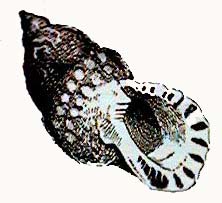
Knobbed Triton
Illustration by Chris HicksIt measured 222 mm total length. Weight drained 1128 grams. The specimen is alive. I took the Triton to the Guernsey Aquarium on 18 October 1999.
This large gastropod has only been recorded in British seas on a few occasions. It is a southerly species known from the Mediterranean Sea.Report by Richard Lord (Guernsey)More Information
EMail:fishinfo@guernsey.net
In late September 1999 Chris Gilbertson (Mevagissey Aquarium) was given a specimen brought in by a fisherman, caught off the south Cornish coast.10 October 1999
Nigel Hunter (Littleborough, Lancashire) discovered a Leatherback Turtle, Dermochelys coriacea, decomposing on Newborough island beach on the Isle of Anglesey. The turtle was nearly 2 metres long and nearly a metre (90 cm) wide.
BMLSS Turtle Page10 October 1999
Five Risso's Dolphins, Grampus griseus, were seen between Porthellick and Peninnis, off the east coast of St. Mary's, Isles of Scilly, in the morning. These dolphins are being more commonly reported off Cornwall in the last two years.
Previous Report
Report from Vince Smith's One-List/Cornish Wildlife
Send a message to the list at: CornishWildlife@onelist.com9 October 1999
A small Long-finned Pilot Whale, Globicephala melas, (Family: Delphinidae) was spotted by angler John Luff-Smith in the Thames estuary, near Southend, swimming towards London. Although probably not regarded as a special mention from around most of the British coast, they are rarely seen in the south-east, although they are known from the seas off Sussex.Report from the Whale & Conservation SocietyCetacean Page5 October 1999
Several Common (Couch's) Sea Bream, Pagrus pagrus (=Sparus), have been caught in the last few weeks. There seems to be a small school, probably on Guernsey's east coast, because the same fisherman catches them. One Couch's Sea Bream caught on September 7 weighed 1.95 kg (4 lb 4¾ oz) I found one at the fish market (landed on October 5) that weighed 1.72 kg (3 lb 12¾ oz) (total length 45 cm, fork length 39 cm).
This Mediterranean and tropical Atlantic fish is rare in the English Channel and common, but not an abundant fish of sand bottoms and eelgrass beds. It rarely exceeds 50 cm in length and 2.5 kg in weight.Report by Richard Lord (Guernsey)5 October 1999
EMail:fishinfo@guernsey.net
Tens of thousands By-the-Wind Sailor, Velella velella, were discovered by Paul Gainey, washed up on the shore between Gwithian and Mexico Beach on the north coast of Cornwall (see the entry below). They were also reported at Sennen Cove (near Land's End) by Jane Herbert.
Photographs by Richard Lord
Jellyfish Page (Velella)
Reports on the Seaquest SW (Cornwall Wildlife Trust web pages).3 October 1999
Three Ocean Sunfish, Mola mola, were spotted near St. Ives, Cornwall.from Brian StoneFull Report Reports of the Sunfish from off Cornish shores are frequent during the summer months. In British seas they vary in size from 40 cm to nearly two metres in length, but they can grow considerably larger. Some of the observations are listed on the Seaquest SW (Cornwall Wildlife Trust web pages).
Sunfish Page2 October 1999
A Portuguese Man o'War, Physalia physalis, was washed up on Porthcothan Beach (just south of Padstow) (SW8572), Cornwall. This colonial hydrozoan (jellyfish-like invertebrate animal) has a float bladder that was fully inflated and 22 cm in length. There were quite a thick bunch of stinging tentacles still attached, to a length of about 15 cm. It was washed in with the incoming tide after a period of south-westerly strong winds.

Portuguese Man o'War
(Photograph by Jane Herbert, Editor of the Cornwall Wildlife Trust web site)As expected, several more Portuguese Men o'War were discovered, five on Porthcothan, two on Watergate Bay and Paul Gainey found five on Gwithian (Hayle) beaches, over the weekend. Most specimens were alive and some have been placed in an aquarium for further study.
By Sunday night the tally had increased to 22 from Hayle up to Trevose Head. The tentacles on the biggest were well over a metre long, possibly twice that length (had they been given the chance to extend fully).
Jellyfish Page (Portuguese Man o'War)Report by Nick Darke (Cornwall)Portuguese Men o'War reported over a large area of the coast of Cornwall and the Isles of Scilly . Over 100 specimens and there were probably many more stranded in inaccessible coves.Stella Turk (Cornish WWT)Portuguese Men o'War: Further Information on the Cornwall Wildlife Trust site.
On 8 October 1999, a couple of Portuguese Men o'War were discovered washed up on the west coast of Guernsey, Channel Islands, and this may just the first of a large swarm.Report by Richard Lord (Guernsey)
26 September 1999
A juvenile Common Dolphin, Delphinus delphis, was seen by Stephen Westcott playing around the boats in the Helford River, Cornwall, in the late afternoon.
More information and Reports on the Seaquest SW (Cornwall Wildlife Trust web pages).22 September 1999
A large Tope, Galeorhinus galeus, weighing between 38 and 40 kg (85 to 90 lb), was tagged and released off the Isles of Mull, Scotland.
(The photographs do not bear out this estimate weight and it may be much less.)
The current rod and line record of , is 37.4 kg (82 lb 8 oz) for a Tope caught off Bradwell-on-Sea, Essex, (southern North Sea) in 1991.
More Information on Tope(Len Nevell, Sea Angling Report)
18 September 1999
A pod ofBottle-nosed Dolphins, Tursiops truncatus, numbering up to 20 individuals were reported by Hazel Meredith in Fistral Bay, (near St. Ives), Cornwall, (SW7961) in an area occupied by bathers.Later in the month pods were reported off Perranporth and Crantock, Cornwall.
Small pods of 5 and 7 Bottle-nosed Dolphins were seen in Mount's Bay and Gwithian, Cornwall, on 15 & 17 October 1999.
More information and Reports on the Seaquest SW (Cornwall Wildlife Trust web pages).
BMLSS Cetacean Page16 September 1999
A Slipper Lobster, Scyllarus arctus, was trawled up off Wolf Rock, off the Cornish coast, and this was only the second record off the Cornish coast this century. This crustacean (it looks a bit like a compressed Lobster) has two shrimp (Crangon)-like pincers and a carapace probably as wide as a Lobsters', but it is still less than half the length (excluding the long claws of a Lobster). BMLSS records have two specimens discovered off Dorset, one trawled and one seen by a diver, several years ago before the web site records were compiled, from 1996. The Slipper Lobster is a southern species found in the Mediterranean Sea. It is classified in the Infraorder Palinura: see taxonomy notes.
Another Slipper Lobster was caught off the south coast of Cornwall in June 1999.
Discovery Report by Doug Herdson. National Marine Aquarium at Plymouth).
Notes by Andy Horton.
Crustacea Page3 September
The Scottish Executive confirmed that the South East Islay Skerries on the Scottish island of Islay are to be re-considered as a proposed Special Area of Conservation (SAC) for Harbour Seals, Phoca vitulina vitulina, under the European Community's Habitats Directive. The decision comes after a petition was presented in the legal courts by the owners of an Islay seal sanctuary against the Scottish Executive for its decision to drop the site from its list of proposed SACs. The seal sanctuary is based at the proposed SAC site and releases its seals into the site.
First ReportSeptember 1999
A sick and exhausted six month old female Hooded Seal, Cystophora cristata, found in the Orkney Islands, Scotland, was only the third one to have been seen in the islands. She was taken in by Orkney Seal Rescue but unfortunately died after only a few days. For more information, contact Ross Flett, Orkney Seal Rescue. EMail: selkiesave@aol.com. Seal Conservation Society
Seals Page31 August 1999
A Northern Bottle-nosed Whale, Hyperoodon ampullatus, was reported stranded at Ross, Killala, County Mayo, north-west Ireland (Eire, Republic of Ireland) (south of Donegal). The whale refloated itself but then became stranded on Bartra Island. Despite strenuous rescue attempts the whale perished on the beach. This deep water whale is rare even off the west coast of Ireland.
Report from the Irish Whale & Dolphin Group (Link)
Previous Record
Cetacean Page
Stranded Cetacean Report Numbers30 August 1999
A Leatherback Turtle, Dermochelys coriacea, weighing 500 kg* was discovered alive but in a poor condition one mile off Roker, Sunderland, in the north-east of England. It was captured but died shortly afterwards. The turtle measured 2.1 metres (7 ft) long and 1.5 metres (5 ft) wide. Turtles feed on jellyfishes and the abundance of jellyfishes is thought to be the reason for its occurrence. (* the original report estimated the weight at 750 kg)
Jellyfish (NE England) LinkReport by Wayne Curtis (Sunderland)
28 August 1999
A commercial fishermen found the beautiful orange starfish, Echinaster sepositus, north of Herm Island. The crab potter has fished for 20 years and had never seen one before. The books say that this starfish reaches the northern edge of its range in the Channel Islands.Report by Richard Lord (Guernsey)Echinodermata Page
EMail:fishinfo@guernsey.netAugust 1999
Ormer Deaths
The prized mollusc known as the Ormer, Haliotis tuberculata, found only around the Channel Islands in U.K. seas, but found also on the French side of the English Channel, has suffered a mysterious series of deaths in the sea and on the reefs to the south of the island of Jersey.The cause of this serious problem, which has decimated the numbers and threatens to almost wipe out the population, is unknown. Last year, 1998, the Ormers on the French coast suffered a similar mortality, and this year the remaining Ormers in French seas suffered the same fate.
Report by Sue DalyFurther Information
Green Ormer Database26 August 1999
Fishermen (6 witnesses) from Cornwall reported a large predatory shark off Padstow, Cornwall, with a length reported of 3.6 metres (11 ft). If allowances are made for exaggeration, it could be a Porbeagle Shark, Lamna nasus, that attains a length of 3 metres, or a Shortfin Mako, Isurus oxyrinchus, which could reach a length of nearly 4 metres (my favourite guess). The Mako is a dangerous shark although attacks on humans are rare, virtually non-existent. Occurrences of the warm water Mako in British seas are usually recorded in August and are rare, although they are occasionally caught in commercial nets.
The report appeared in the Sun newspaper when it was identified as the Great White Shark, Carcharodon carcharias, which is unknown from British seas. This identification has not been ruled out. It is, however, extremely unlikely.
If it is a Great White its occurrence in area where large numbers of larger Basking Sharks have been seen may not be a coincidence. Great Whites could prey on them.
Discussion
Shark Page
Influx of Basking Sharks off north Cornwall24 August 1999
An Almaco Jack, Seriola rivoliana, was caught near the Eddystone Reef, off Plymouth, south Devon, and brought straight to Doug Herdson at the National Aquarium, Plymouth. This fish has been examined by Roger Swinfen of the MBA and Doug Herdson and they are confident of the identification.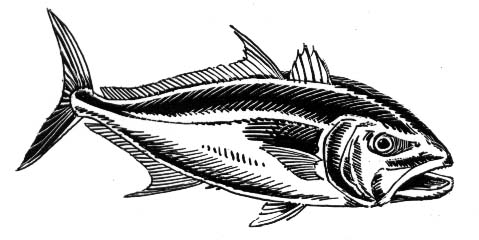
This is only the second U.K. record for this tropical fish native to the Caribbean. The fish was captured in a bottom set net fishing for Pollack at 16 metres depth, 2 miles off the Eddystone rock. Its total length was 42 cm and it weighed 980 grams. The Amberjack, Seriola dumerili, is the member of this genus of fishes that is most often recorded in British seas, but this warm water migrant is extremely rare. It is a predator of smaller fishes.
On 17 October 1999 a spearfisherman caught one out of couple of Almaco Jacks seen off Plymouth Breakwater, south Devon.Report from the National Aquarium, PlymouthMore Information (External)
BMLSS Fish Page13 August 1999
A large 180 kg (400 lb) Swordfish, Xiphias gladius, was caught off the Cornish coast and put on display at Brighton. These large fish are extremely rare off the British coast. One was seen off the Isle of Wight a few years ago.
(this specimen may actually have been caught further afield, e.g. Biscay, and brought in by the Newlyn, Cornwall, boats).
Previous Record Link11 August 1999
A large Comber, Serranus cabrilla, was caught by angler Clifton Morris on a fishing trip off Penzance, Cornwall. This fish usually attains a weight of 500 grams at a length of 30 cm, but larger specimens are known. This specimen weighed 440 grams.(Len Nevell, Sea Angling Report)
Comber (Photograph by Ricardo Fernandez)
The Comber is a fish found in the Mediterranean Sea and off the Atlantic coasts of western Europe, with its most northerly point of distribution in the Bay of Biscay.
11 August 1999
Dr. David Hicks and the rest of the crew on a short voyage from Lundy to Tintagel spotted 30 to 40 Basking Sharks over a small area approximately 12 miles NNE of Tintagel (NW Cornwall). There were also isolated pairs 4 miles south west of Lundy.
Full Report
Basking Shark page11 August 1999
Total Eclipse of the Sun over Cornwall c.11.11 am
Partial Eclipse at Shoreham-by-Sea, figures (unofficial).
Best Eclipse Photographs (from Cornwall)8 August 1999
A Leatherback Turtle, Dermochelys coriacea, was seen swimming in the sea off the southern end of Bressay (between the Ord and the Bard) in the Shetland Islands by John Tulloch this evening. It is the only the ninth live individual to be seen in Shetland waters and was estimated to be around 150 cm (5 feet) in length.
On 2 September 1999, a large turtle, estimated to be about 1 metre in length and was reported in Bluemull Sound, between Yell and Unst, in the Shetland Isles, by the crew of the Fetlar ferry.
Shetland Wildlife News Web Site (more information and a photograph)8 August 1999
A Sunfish, Mola mola, jumped out of the water three times, a half a mile off Kimmeridge, Dorset.
Report by Peter Tinsley (Marine Awareness Officer, Dorset Wildlife Trust).
Reports of the Sunfish from off Cornish shores are frequent during the summer months. Some of the observations are listed on the Seaquest SW (Cornwall Wildlife Trust web pages).2 August 1999
A large pod of 150-200 White-sided Dolphins, Lagenorhynchus acutus, were seen off North Unst in the Shetland Islands, with 2 Minke Whales, Balaenoptera acutorostrata.
Shetland Wildlife News Web Site (includes several recent Killer Whale, Orcinus orca, reports on this site)1 August 1999
1 August 1999
The Scottish Wildlife Trust paid tribute to the mystery benefactor whose cash gift enabled them to buy the 56 hectare uninhabited island ofLinga Holm, in the Orkney Islands, Scotland, as a sanctuary for Grey Seals, Halichoerus grypus. Linga Holm is the world's third largest island-based breeding colony of Grey Seals with 2,300 pups having been counted there in 1997.
Scottish Wildlife Trust at EMail: scottishwt@cix.compulink.co.uk
A single specimen of the nudibranch Tritonia lineata was discovered by Gavin Bushell diving alone off Porth Eilian, Isle of Anglesey, NW Wales. It was discovered on the west side of Point Linas, over a sea bottom that had large boulders scattered around, but generally was covered in a dense fine silt. And it was on a patch of this silt between the boulders that the nudibranch was discovered at a depth of 8 metres.
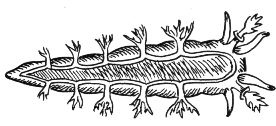
This species is probably not rare, but it is rarely reported from any location other than around the islands of Skomer (SW Wales) and Lundy (Bristol Channel). It has not been recorded intertidally, and its infrequency of reporting by divers maybe because it inhabits silty conditions which tend to be unpopular with divers because of their poor visibility when the silt is churned up, and because such sites do not prove as interesting as hard rock areas.
More Information
BMLSS Nudibranch Pages (Record of Discoveries)4 August 1999
ASharp-nosed Seven-gilled Shark, Heptranchias perlo, was caught on a Tuna long-line set near the surface 120 miles SSW (sea depth between 100 & 200 metres) of the Isles of Scilly . This only the third record of this shark in British waters, the other records occurring off Cornwall and southern Ireland. The total length of the shark was 102 cm.
More information is held on this discovery.
Shark Page29 July 1999
A pod of 12 Bottle-nosed Dolphins, Tursiops truncatus, are seen just 200 metres from the shore off Worthing, West Sussex during a heatwave, when temperatures reached 29º C. Dolphins are rarely seen off the Sussex coast.
Dolphins off Sussex 199928 July 1999
Scientists at the National Marine Aquarium Plymouth today were excited by the excellent pictures received from satellite of a huge plankton bloom which coloured the sea white off the coasts of Devon and Cornwall. This colouring was caused by minute marine algae (a coccolith) called Emiliania huxleyi which sheds its chalky outer casing colouring the sea a milky white and was probably brought about by the continuing hot weather and warm seas. These plankton blooms have been seen before but they were usually much further out in the ocean, and are reported to be completely harmless. The phenomenon has been dubbed The Maritime Milky Way.
Scientists have also been taking water samples from the Fal estuary, Cornwall, where a potentially toxic reddish brown algae known as a red tide has been spotted. The algae has affected the estuary in previous years and can cause a loss of marine life, especially benthic species.
Cornish Marine Wildlife Reports 1999 (by Ray Dennis)
More information on Emiliania huxleyi in this book (link)28 July 1999
David de la Moche appeared to have been attacked by the parasitic fish known as a Lamprey, Petromyzon marinus, whilst swimming off Folkestone in shallow water.
Full Report (Forum page)
Lamprey25 July 1999
Numerous children (at least 8) have been treated for Lion's Mane Jellyfish, Cyanea capillata, stings off the north-east coast of England. This Arctic species has been blown inshore by the north-easterly winds.Jellyfish of various sizes, were seen between the north and south piers at Roker, Sunderland, the majority were purple in colour. At least one was roughly the size of a dustbin lid. More information.
Photograph & Report by Wayne Curtis (Sunderland)EMail: jan@canisway.freeserve.co.uk
I think it is probably the venomous Lion's Mane Jellyfish, Cyanea capillata. The sting is reckoned to be less painful than a wasp sting. The wound is best washed in tap water. Some people are allergic to the stings. AH.Report of a Sting
BMLSS Moon & other Jellyfish page

Norwegian Marine ***
These web pages are recommended for photographs of Jellyfish21 July 1999
A new licensing scheme is being proposed by the Government to protect crustaceans and other shellfish from being over-exploited. Fisheries Minister Elliot Morley said that there has been "increasing concern about the rate of exploitation of shellfish stocks in UK waters. The current state of shellfish stocks requires us to make progress in conserving this vulnerable resource. The new scheme is likely to reduce the number of boats fishing for shellfish to around 3,000...."
The value of the shellfish industry in the UK is now £165 million, or one third of all UK fish landings.
http://www.bbc.co.uk/animalzone/93news3.shtml
18 July 1999
Fishing and farming for the King Scallop, Pecten maximus, and the Queen Scallop, Aequipecten opercularis was banned off the west coast and islands of Scotland because of a build up of a naturally occurring toxin in the flesh of the scallop. The ban covered 8000 square miles from the Outer Hebrides south to the islands of Jura and Islay. The toxin causes Amnesiac Shellfish Poisoning and the symptoms when ingested by humans include memory loss, headaches, vomiting, and even death in serious cases. This toxic bloom was first reported off the Canadian coast in 1990 (Ref.) The offending organism in Canada was the pennate diatom Nitzschia pungens.
King Scallop, Pecten maximus
Plankton Blooms 1999 (Times article 31 July 1999 Link)
11 -13 July 1999
A Silver Dory (=Sailfin Dory), Zenopsis conchifer, is caught by a commercial fishing vessel 'Wayfarer' E. of Labadie Bank, off Cornwall. This is only the second record for this deep water fish that is so rarely caught that it is not included in the popular record of British fishes.Record from the Geoff Potts and Swaby British Fish Records2002 record of this fish11 July 1999
The Grey Seal pup loses its tracking equipment.
Description of the missing satellite tag.
See below (click on this text)10 July 1999
A White-beaked Dolphin, Lagenorhynchus albirostris, was found stranded on the beach dead, west of Shag Rock, Cornwall (SX174507). There are only a handful of records of this dolphin species from the seas around Cornwall. The dolphin had already been attacked by scavengers.
More information and Reports on the Seaquest SW (Cornwall Wildlife Trust web pages).
Report by Vivian Nicholls & Victor Copeland.9 July 1999
Proposal to include the Basking Shark (Cetorhinus maximus) on Appendix II of the Convention on International Trade in Endangered Species (CITES)
DETR http://www.wildlife-countryside.detr.gov.uk/gwd/shark/Index.htm7 July 1999
A report during the first week of July from a Cornish Fish Producers Organisation vessel said that they counted 126 Basking Sharks, Cetorhinus maximus, (but there were hundreds present) 2 miles north of the Longships Lighthouse, also in the area was a 15 metre (50 ft) baleen whale with a juvenile, and a Killer Whale, Orcinus orca.
Cornish Marine Wildlife Reports 1999 (by Ray Dennis)
More July reports from Cornwall (BMLSS Basking Shark 2 page)29 June 1999
Seahenge
Archaeologists from English Heritage planned the removal of the Bronze Age (2049 BC) circle of wooden posts (discovered in November 1998, near Holme-next-the-Sea, Norfolk, when the sea eroded the peat protecting the Monument) known as Seahenge (or Woodhenge) just 7 days after the Summer Solstice. The Monument is being dug up and moved to the Flag Fen Centre near Peterborough, Cambridgeshire, to prevent it being eroded and destroyed by the sea, and for further study.
Woodhenge Site (with an excellent photograph and lots of information)
BBC News site:
http://193.130.149.130/hi/english/sci/tech/newsid_353000/353337.stm27 June 1999
A Grey Seal pup was released from Dublin on 27 June 1999 with £5000 worth of satellite tracking equipment fastened to its head. The signals stopped off the Isle of Colonay, SW Scotland on 11 July 1999. The seal has never been heard of again and the tracking equipment has not been recovered.
More Information25 June 1999
A Common Octopus, Octopus vulgaris, was seen by a diver off off Dodman, Cornwall (SX0039). It was a metre across. Common Octopuses are only rarely discovered even off the south-western coasts. However, in the past, before the cold winter of 1963, they may have been commoner.
Discovery Report by Doug Herdson. National Marine Aquarium at Plymouth).
Notes by Andy Horton.BMLSS Octopus Page
More Information (John Liddiard External Site)
24 June 1999
An all white Risso's Dolphin, Grampus griseus, was spotted by Jean Lawman one mile north of Pendeen, Cornwall, (SW3736). This is a dolphin not normally spotted off the British mainland coasts.
Stranded Risso's Dolphin Report
More information and Reports on the Seaquest SW (Cornwall Wildlife Trust web pages).23 June 1999
Three species of large cetacean were seen off Sumburgh Head, the most southerly headland of the Shetland Isles. These include two species of large baleen whales, with two Humpback Whales, Megaptera novaeangliae, and five Minke Whales, Balaenoptera acutorostrata, together with the ominous presence of five predatory Killer Whales, Orcinus orca.
A young Minke Whale was also found stranded on the beach dead.
These large cetaceans were also reported from the same area on 5 July 1999.
Shetland Wildlife News Web Site (lots more cetacean reports on this site)
BMLSS Cetacean PageJune 1999
Rohan Holt discovered a huge 62 acre bed of Mantis Shrimps, Rissoides desmaresti, at a depth of 8 to 15 metres off the coast of north Wales in Cardigan Bay.Photograph by Rohan Holt
Although, the plankton have been discovered in the plankton and the adults recovered from the stomach of Cod, this was first discovery I have heard of these crustaceans in British seas. They live in burrows in huge numbers. Although only 10 cm long, like all Mantis Shrimps (Stomatopods), they are well armed (they have a single serrated digit similar to a preying mantis) and the telson is also heavily spined and capable of inflicting injury.
More Information
Lurker's Guide to StomatopodsJune 1999
An Osprey, Pandion haliaetus, is hunting around Stanbury Point, Thorney Island, (the large peninsula in Chichester Harbour, West Sussex) near where there is a roost of 10Little Egrets, Egretta garzetta.
Havant Nature Notes
BMLSS Sea Birds page (a few notes only)June 1999
Another Porbeagle Shark, Lamna nasus, weighing 89.92 kg (198 lb 4 oz) was caught 8 miles west of the Needles, Isle of Wight by angler Chris Knights.22 June 1999
A ten mile oil slick was reported off the north-west coast of England near Barrow-in-Furness. The slick was composed of paraffin which spread rapidly across the surface of the sea and disappeared much more rapidly than crude oil. The oil threatened to enter the Duddon Sands and estuary.
Oilspills Page19 June 1999
A Grey Seal, Halichoerus grypus, was spotted in the fresh water reaches of the River Severn. Grey Seals usually inhabit the sea where there is more food and visits to fresh water are uncommon.17 June 1999
A pod of 7 White-sided Dolphins, Lagenorhynchus acutus, visited Laxfirth Voe (central Mainland), Shetland Islands, in the evening. On 26 June a pod of 20 were seen in the same voe.
Shetland Wildlife News Web Site (including photographs of the dolphins)16 June 1999
The first reports of numbers (10+) of Basking Sharks, Cetorhinus maximus, arrive in Kennack Bay for the second year running.Report by Keith Williams (Cornwall)Basking Sharks 199815 June 1999
A Common Crane, Grus grus, was spotted at Aith in the Shetland Islands during the evening. On the 22 June it was seen at Eswick on the East Mainland (of the Shetland Isles).
Shetland Wildlife News Web Site14 June 1999
A male Risso's Dolphin, Grampus griseus, was discovered 18 miles inland at Inistioge up the River Nore in County Kilkenny, Ireland. The dolphin was injured and in distress. An elaborate rescue was organised by the Irish authorities and volunteers. The dolphin was released into the sea near Dunmore Head and was seen swimming strongly.
Report by Gavin Gerrard, Marine Mammal Rescue, Dublin.
Full Report Link10 June 1999
A male Thresher Shark, Alopia vulpinus, was landed at Plymouth. It was caught in a bottom set net off the south Devon coast. The length was given at 4.04 metres (13 ft +), including the long tail fin which is equal to the body length. The pre-caudal length was 192 cm. Thresher Sharks are usually uncommon summer migrants to the English Channel. However, there is believed to be a small resident population in the western English Channel, especially as the previous capture was in winter.
(Report from Doug Herdson, National Marine Aquarium at Plymouth.)
Shark Page9 June 1999
Six Barrel Jellyfish, Rhizostoma octopus, were washed up on the sandy beach at Ravenglass, Cumbria, in the north-west of England. The definitive dark blue ring around the base of the bell was present but did not show up on the photograph. This jellyfish does not have stinging tentacles like the similar looking Cyanea species, which are sometimes washed up on the same coast.

Report and photograph by Nikki Sheldon (EMail)
Barrel Jellyfish around the Isle of Man 1999
On 27 June 1999, a fisherman reported seeing many of the large jellyfish Rhizostoma octopus along the South Penwith coast, Cornwall.
Cornish Marine Wildlife Reports 1999 (by Ray Dennis)

Norwegian Marine ***
These web pages are recommended for photographs of Jellyfish3 June 1999
A pup has been born on the rookery of a half a dozen Common Seals, Phoca vitulina, on the Pilsey Sands, Chichester Harbour, West Sussex. Seals are uncommon between the Isle of Wight and Dover on the English Channel coast, the total is only about 12.
Ralph Hollins Nature Pages
EMail: jrwhollins@clara.co.ukJune 1999
Ryan Williams and Brett Jose (Cadgwith, Cornwall) spotted a 120 cm long Leatherback Turtle, Dermochelys coriacea, poke its head out of the water whilst they were fishing off Church Cove on the Lizard Peninsula in Cornwall. A Newlyn fishermen also spotted one near the Isles of Scilly .Report by Jake Scolding (Cadgwith)Reports of Leatherback Turtles from off Cornish shores are expected during the summer months. Some of the observations are listed on the Seaquest SW (Cornwall Wildlife Trust web pages).
A Killer Whale, Orcinus orca, was spotted off the Cornish coast near Land's End.
Basking Sharks, Cetorhinus maximus, have been seen off the Cornish coast in increasing numbers.30 May 1999
A small Electric Ray, Torpedo nobiliana, was caught by fisherman John Gillam off Brighton, Sussex. These fish are occasionally caught off the Sussex coast each year. What was unusual about this fish was that it was captured alive and put on display at Brighton Sea Life Centre.
1998 Report from Sussex.A small 26 kg Porbeagle Shark, Lamna nasus, was caught off Brighton by Derek Dalmon. This is a rare capture off Sussex, but the second record this year.
First record.May 1999
Basking Sharks, Cetorhinus maximus, have been seen in groups of up to 20 at a time from Start Bay (Dartmouth, Devon), and 12 around Land's End, Cornwall.
Basking Sharks 1998 Link27 May 1999
Marion Wood (BMLSS) spotted a pod of about 6 Dolphins 100 metres off Shoreham Beach, Sussex, in the early evening with at least three jumping out of the water at one time. They swam very quickly east towards Brighton.
Charlie Hubbard also spotted a pod of dolphins bow-riding the fishery protection vessel "Watchful".
Bottle-nosed Dolphins, Tursiops truncatus, have been identified in Chichester Harbour, West Sussex.26 May 1999
A young (about 3 metres long) Minke Whale, Balaenoptera acutorostrata, was washed up on the beach at Penberth Cove, a granite bay just south of Land's End, Cornwall. Under the supervision of the RSPCA, a band of rescuers floated the whale back out to sea.Daily Mail Report19 May 1999
The first Dolphins of the year were seen off Rottingdean, east of Brighton, Sussex. A pod of 4 were seen from the promenade swimming west towards Brighton.
Cetacean Page
Sussex CetaceansMay 1999
Moon Jellyfish, Aurelia aurita, swarmed in thousands in Shoreham Harbour, Sussex. This jellyfish is common and widespread throughout the oceans of the world and is common all around the coast of Britain. It would not deserve a special comment if they had been recorded regularly at this location before - they had been for about 4 years, but not in such numbers. The largest specimens reached 25 cm in diameter. In some specimens the four rounded pinkish masses, which are the gonads, could be seen. An occasional specimen had 6 rings.
Richard Huggett reports thousands from off Eastbourne, 20 miles to the east up the English Channel, so the swarms must occur all along the English Channel. It seems a good year of all species of jellyfish around Britain with records of the venomous Lions' Mane Jellyfish, Cyanea capillata from Scotland in larger numbers this year. Nigel Smith (Sea Probe) reports 500 Moon Jellyfish in an area of 75 square metres around the island of Skye, Scotland. One had a diameter of 40 cm.May 1999
Sea Hares, Aplysia punctata, have been reported in large numbers from just off the Isle of Purbeck on the Dorset coast (Jane Lilley), near Portland Harbour on the Dorset coast (Bob Alexander) and Saline Bay in Guernsey, Channel Islands (Richard Lord). All reports of this mollusc are of interest. It will not be until next month that we will know if it is a year of abundance, when Sea Hares come inshore to spawn and then die on the shore and in shallow water.
In July they were also reported from the mouth of the Rive Exe, Seaton, Devon, (Peter Glanvill) and in hundreds off Lulworth Cove, Dorset (Chris Davis, Marine Conservation Society).16 May 1999
A pod of 5 Killer Whales, Orcinus orca, were observed about 5 miles south of Sumburgh Head, the most southerly point of the Shetland Isles.
Previous sighting.
Shetland Wildlife News Web Site7 May 1999
A small (about 3 metres long) Minke Whale, Balaenoptera acutorostrata, was washed up dead under the cliff near Kimmeridge, Dorset. Although dolphins have been known to be stranded on Dorset shores, whale strandings are very rare this far up the English Channel. The whale was stranded about a couple of miles to the east of Kimmeridge Beach. This isolated part of the beach is only accessible without wading at low spring tides.The whale can be seen from the top of the cliff. Minkes are the smallest of the baleen whales, only slightly larger than Killer Whales.
Photograph & Report by Kim Taylor (Guildford)
4 May 1999
A 2779 gram (98 oz.) female Eagle Ray, Myliobatis aquila, was caught by trawl in 15 metres of water at about 2000 hours on Schole bank, off Guernsey, Channel Islands, English Channel. The bank is composed of broken shell and sand.
The Eagle Ray was caught with Blonde Rays, Brill and a few Lesser Spotted Dogfish.
The Eagle Ray had a wing span of 585 mm and a total length of 956 mm. The body length (tip of snout to origin of tail) was 330 mm.
The stomach and spiral valve contained two small squat lobsters, one hermit crab, and pieces of scallop shell. The liver weighed 150 grams and the Eagle Ray weighed 2384 grams gutted.
The Eagle Ray is a summer migrant to the English Channel.Report by Richard Lord (Guernsey)
EMail:fishinfo@guernsey.net
April 1999
A helicopter pilot from Culdrose reported seeing hundreds of dolphins near the Wolf Rock lighthouse. These were probably Common Dolphins, Delphinus delphis, for they have been reported in large numbers in the area by fishermen in the past.
Cornish Marine Wildlife Reports 1999 (by Ray Dennis)24 April 1999
The Environmental Agency announced that the stocks of migrating Atlantic Salmon, Salmo salmo, are at a frightening low level. The numbers are so low that they have been placed on the 'endangered list'. Just 1,200 spring Salmon were caught in England and Wales whereas in 1989 the figure was 8,000. All wild caught Salmon before 1 June by rod or in nets must now be returned to the water to preserve stocks and to prevent imminent extinction in some rivers. The ban will be enforced for 10 years (from 14 April 1999). The numbers in the famous River Test chalk stream (Hampshire) may be down to 800.17 April 1999
1000+ protesters lined the chalk cliffs at Telscombe Cliffs (pic), near Brighton, Sussex, at plans by Southern Water to build a huge sewage works that would destroy a valuable chalk cliff-edge wildlife site and threaten the prominent 30 metres high chalk cliffs a designated SSSI site because of its national geological importance.
Friends of the Earth SSSI Navigator
http://www.foe.co.uk/wildplaces/intros/intro2.html
Use this URL to find the SSSIs throughout Britain
Subsequent research seems to indicate that some sort of sea defence work will be necessary to protect the cliffs. Ecological change will occur to the chalk wave-cut platform, but this will not necessarily be detrimental. AH.11 April 1999
A pod of 3 Killer Whales, Orcinus orca, (a bull, a female and a calf) were spotted off Sumburgh Head, the most southerly tip of the Shetland Islands.
On 1 April, a Minke Whale, Balaenoptera acutorostrata, was seen in the same area.
Shetland Wildlife News Web Site
Lots of bird reports on this site, including Common Cranes, Gyrfalcon, Osprey, Glaucous Gull, and from their 1998 archives the White-tailed Sea Eagle.4 April 1999
Several thousand of the Common Starfish, Asterias rubens, were washed up dead on the northern point of the Isle of Man over the Easter period.Report by Mike Bates (Port Erin Marine Lab.)3 April 1999
A Walrus, Odobenus rosmarus rosmarus was seen hauled out on rocks at Kilsallagh, near Old Head, Clew Bay, in County Mayo, Ireland for six hours. Lying within 100 metres of the busy coastal road and spotted as a "rock that moved", the resting walrus finally disappeared at dusk. There have been several walrus sightings at sea off County Donegal in recent winters, and a couple of walruses were reported to have been seen by surfers in Killala Bay in December. A dead walrus was found in County Kerry in January 1995.
The Walrus is an Arctic species and is rarely seen even off Scotland and the Shetland Isles.Report in the Irish Times & Pinniped NewsSeals Page
Seal Conservation Society21 March 1999
A small pod of Porpoises, Phocoena phocoena, were spotted off Selsey, West Sussex, where they are rarely seen.
More.
18 March 1999
A Moray Eel, Muraena helena, turned up on the Newlyn Fish market, Cornwall.. Apparently it was caught 100 miles out in the South Western approaches.
From Cornish Marine Life Records (Ray Dennis) 199911 March 1999
A Sperm Whale, Physeter macrocephalus, carcass was washed ashore at Hillswick (north Mainland), Shetland Isles. The animal about 10 metres in length was fairly decomposed and had lost most of its skin.
Shetland Wildlife News Web Site10 March 1999
A 103 kg (total weight) female Porbeagle Shark, Lamna nasus, was landed at St. Peter Port Harbour, Guernsey.
Porbeagle
Illustration by Chris HicksIt was caught in a monofilament gill net off the south-west Coast of Guernsey in about 20 metres (60 feet) of water. The gill net was set for Sea Bass, Dicentrarchus labrax.
The Porbeagle was wrapped in the net and dead when brought aboard.Report by Richard Lord (Guernsey)More information about this shark.
EMail:fishinfo@guernsey.net
Shark Trust9 March 1999
The first Basking Shark, Cetorhinus maximus, of the year is observed 100 miles east of Longships light (Land's End) by Ken Carson, a skipper of an angling boat. The shark was 4 metres long.March 1999
A marine Special Area of Conservation (SAC) for Harbour Seals, Phoca vitulina vitulina, has been proposed under the EC Habitats Directive for an area around the island of Sanday in the Scottish Orkney Islands. Scottish Natural Heritage (SNH) has begun a public consultation exercise on the proposed site.
For more information, contact Ross Flett, Orkney Seal Rescue, at
EMail: SelkieSave@aol.com or Tel: +44-(0)1856-831463.SNH also announced that it has deferred notification of the South East Islay Skerries, an important area for the Harbour Seal, as a Site of Special Scientific Interest (SSSI). SSSI designation is necessary to underpin designation as a SAC, for which the area has been proposed by the government as a candidate site. Although both the U.K. Sea Mammal Research Unit and the Advisory Committee on SSSI's specialist adviser supported the SNH's view that the site met the requirements for designation, the decision to defer notification came after the objection and compilation of a report by a local landowner, Sir John MacTaggart.
For more information, contact Nancy Fraser, Public Relations
Officer, SNH West Areas, on Tel: +44-(0)141-951-4488 or John Robins, Animal Concern, at
EMail: john@jfrobins.force9.co.uk or Tel: +44-(0)141-445-3570.
(Sources: Animal Concern; Orkney Seal Rescue; SNH)
Report from Paul Haddow, Pinniped News.
Latest News in this Notification (Autumn 1999)26 February 1999
A 230 cm (Total length, pre-caudal was 109 cm) male Thresher Shark, Alopius vulpinus, was taken in midwater 16 miles SSW of Eddystone Rocks, south of Plymouth, Cornwall.
Report by Philip Vas. Confirmed by Doug Herdson.
British Shark GuideFebruary 1999
Four Risso's Dolphins, Grampus griseus, were found washed up dead on Cornish beaches this year. Like the Common Dolphins, Delphinus delphis, which are always washed up at this time of the year, the dead cetaceans showed evidence of fishing net entanglements. Risso's Dolphins have only been recorded on Cornish shores 16 times since 1914. One specimen was stranded at Northcott Mouth, Bude, on the north coast.
Report and photograph by Colin Speedie, Seaquest SW.
Cetacean Page12 February 1999
A Sturgeon, Acipenser sturio, of 8.05 kg (nearly 18 lb) was caught in gill nets off Looe, in south Cornwall, and brought into Plymouth Fish Market.
Report by Alan Knight.12 February 1999
The World of Seahorse Exhibition at the National Marine Aquarium at Plymouth opens. Seahorses were already on display, but the new extended Exhibition opened to the public on this date.6 February 1999
Green Ormer
A mystery animal discovered by Richard Huggett (Eastbourne) was originally identified incorrectly by Andy Horton as Haliotis tuberculata. It has now been found to be a foreign species but still an interesting discovery.
Full ReportThis edible mollusc is well known from the Channel Islands. Further information can be found on Sue Daly's site.
Green Ormer Database file1 February 1999
A 3 metres* long female Mako Shark, Isurus oxyrinchus, (the consensus now seems that it is a Porbeagle) was caught three miles off Brighton by cod fishermen and brought into Monteum Fish Market at nearby Shoreham-by-Sea. The shark weighed 172 kg (378 lb). The largest shark normally caught in Sussex seas is the Tope, Galeorhinus galeus, and then only occasionally. Rarely Porbeagle Sharks, Lamna nasus, have even been caught, but this is my first report of a Mako. Reported in the Shoreham Herald.
[* One report said 2.2 metres, excluding the tail fin?]
Shark Page
Letter to Shoreham Herald
PS: On further examination the shark looks like a Porbeagle. Andy Horton 11/2/99.
Further investigation underway.
Shark teeth
The consensus now seems that it is a Porbeagle. Doug Herdson, Marcus Goodsir, Pål Enger, Philip Vas, Steve Barker & others. 16/2/99.
Capt. Tom's Guide to the Differences between the Porbeagle & Mako Shark
5 Porbeagle Sharks were landed at the fish market in Plymouth from September 1998 to February 1999, the largest being a female of 243 cm (115 kg). Doug Herdson. Porbeagle landed in Guernsey on 10 March 1999. Sarah Fowler, Shark Trust.
The Porbeagle has a secondary caudal keel. The Mako is a southern species, whereas the Porbeagle is a temperate water species and found all around the British Isles.
Porbeagle Sharks in the News 199828 January 1999
A 12 metre long Sperm Whale, Physeter macrocephalus, was discovered swimming around in Weisdale Voe (off Hellister) at around 7.30 am. It gave excellent views to the numerous folk who congregated on the shoreline to watch it as it swam around the voe, at times no more than 50 metres from the shoreline, occasionally lifting its head clear of the water. By noon it had moved further south, into the mouth of the voe, but was still not clear of the Scalloway Islands.
More information including photographs can be found at:
Shetland Wildlife News Web Site28 January 1999
A steel canopy is moored over the war grave and wreck (sunk in 1939) of the Battleship "Royal Oak" in Scapa Flow in the Orkneys to ameliorate the continual oil flow from the ship.25 - 30 January 1999
A cetacean, first believed to be a Porpoise was spotted in the River Trent at Gainsborough. It was identified as a Dolphin, but the exact species was not identified. The dolphin was believed to have stayed around for at least two days and a pair of Dolphins were spotted later in the week.
The River Trent branches off the Humber estuary a few miles north of Gainsborough, where it is a tidal inlet about 20 metres wide before it narrows north of the town.
Reports by David Turner (Retford, Notts) and Jeff Higgett (Ipswich).23 January 1999 to February 1999
A vagrant Bearded Seal, Erignathus barbatus, made a sustained visit to Hartlepool in north-east England. It is over 2 metres long (6-8 ft), grey (more silvery on underside), very short snout, dark chestnut eyes, long white 'moustache' reaching to well below chin. It sits in water with head and back out of water (apparently typical). It has been much photographed and featured on the local NE BBC TV News on 27 January 1999.
Report by Jeff Higgett (Ipswich).
Seals Web Page
Bearded Seals are a non-migratory Arctic species that feed on molluscs including clams. Hartlepool is so far outside its normal range (there have only been 8 records in the Shetlands, all since 1977) that I expressed doubts about its correct identification. Of the two species of seals resident in British waters it is the Common Seal that has the longest whiskers and the one that be most likely mistaken for a Bearded Seal, if was not for the overall size. Common Seals do not exceed 2 metres in length. Grey Seals reach 3 metres long, are commonly found off north-east England. AH.Bearded Seal, Erignathus barbatus, Hartlepool Fish Quay, Teesside, January 1999 (Martyn Sidwell)
sent in by Steven Gantlett (Editor of Birding World)Bearded Seal (More information)
11 January 1999
A Six-gilled Shark, Hexanchus griseus, was caught off Mevagissey, south Cornwall, and brought into Plymouth Fish Market. This is a deep water species that is rarely caught in the English Channel.
Six-gilled Shark Link
A small 41 cm Sunfish, Mola mola, was caught off Polperro, Cornwall.
(Reports from Doug Herdson, National Marine Aquarium at Plymouth.)10 January 1999
Thousands of tonnes of rock fell into the sea from the chalk cliffs at Beachy Head, Sussex. The usual method of natural erosion involves the rainwater freezing and expanding in the friable chalk. There had been a lot of rain followed by a period of sub-zero temperatures. Along a stretch of about 170 metres about a 15 metres wide area of cliff grassland (downs) has disappeared. This is the biggest rock fall at this location within recent memory.
Landslides at Beachy Head
8 January 1999
Jonathan Wills reported a large pod of around 40-50 Harbour Porpoises, Phocoena phocoena, seen in the area of Stoura Baa, about a quarter mile north of Hamna Voe / Boatsroom Voe, Lunna Ness (peninsula, north-east Mainland), in the Shetland Isles, during a monthly winter bird count. It is the largest school seen by Jonathan in this area since September 1994.
NB: The Shetland Isles are the only place around the British Isles where the declining Harbour Porpoise can still be seen in large pods. In the south-east Shetlands, sand-eels are the most important item of prey.
Shetland Wildlife News Web Site
Shetland Sea Mammal Group
Shetland Wildlife Pages Index
New Book on the Shetland Isles5 January 1999
A bull Sperm Whale, Physeter macrocephalus, carcass was found washed ashore on the beach at Flitsland on the west side of Noss (east of Bressay), Shetland Isles. It was 12 metres long and had lost most of its outer layer of skin, but was otherwise mostly intact. Sperm Whales in Shetland seas are usually males; the females remain in deeper water. (from the book)
Report from the:
British Marine Life Study Society
| FIVE KINGDOMS TAXONOMIC INDEX TO BRITISH
MARINE WILDLIFE
Use these links if your are familiar with the scientific classifications of marine life |
The BMLSS (England) site commenced on 1 January 1997.
|
|
|
 |
|
|
Copyright 1999 British Marine Life Study Society
|
|
|
|
|
|
Membership Form |
|
